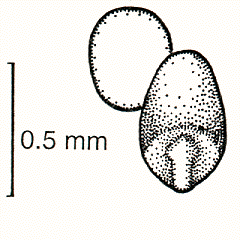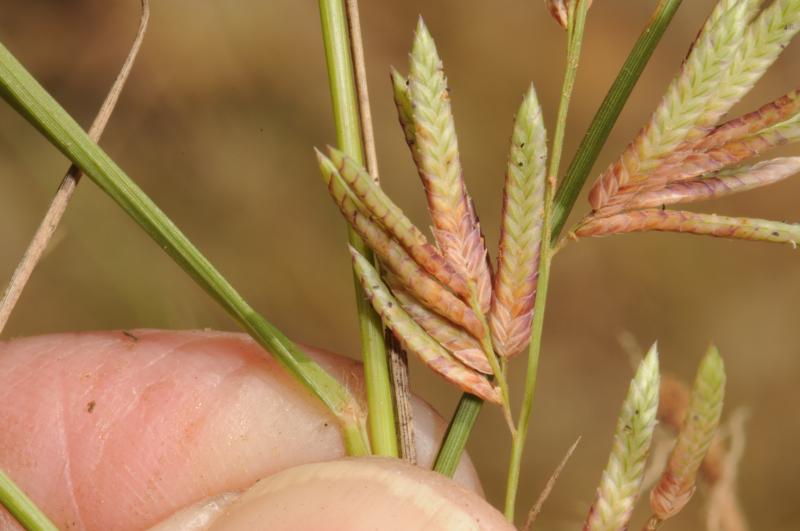Eragrostis elongata (Willd.) Jacq. Eclog.
Gram. 3 (1813).
Classification. (GPWG 2001) : Subfamily
Chloridoideae. Cynodonteae.
Basionym and/or
Replacement Name: Poa elongata Willd.,
Enum. Pl. 1: 108 (1809).
Type of Basionym or Protologue Information: T: India (L).
Recent synonyms: E. contigua, E. diandra.
Key references
(books and floras): [1810]. R.Brown, Prodromus (180 as P.
interrupta, P. diandra), [1878] G.Bentham, Flora Australiensis 7
(646 as Eragrostis diandra), [1952] C.A.Gardner, Flora of Western
Australia 1 Gramineae (121), [1969] E.E.Henty, Manual Grasses
New Guinea (93), [1981] M.Lazarides in J.Jessop (ed)., Flora of
Central Australia (458), [2002] D.Sharp & B.K.Simon, AusGrass,
Grasses of Australia, [2002] J.Wheeler, N.Marchant & M.Lewington, Flora
of the South West (417), [2006] J.Jessop, G.R.M.Dashorst, F.M.James, Grasses
of South Australia (369), [2008] S.W.L.Jacobs, R.D.B.Walley &
D.J.B.Wheeler, Grasses of New South Wales (251).
Illustrations:
[1952] C.A.Gardner, Flora of Western Australia 1 Gramineae (125,
Pl. 36), [2005] K.Mallet (ed.), Flora of Australia 44B: Poaceae 3
(Fig. 71E-F), [2006] J.Jessop, G.R.M.Dashorst, F.M.James, Grasses of South
Australia (369, Fig. 298 & plate
14), [2008] S.W.L.Jacobs, R.D.B.Whalley & D.J.B.Wheeler, Grasses of New
South Wales, 4th edn (251).
Habit.
Perennial. Culms erect, 21–90 cm tall, 2–4 -noded. Lateral branches simple.
Ligule a fringe of hairs, 0.3–0.4 mm long. Leaf-blades straight, filiform, flat
or involute or convolute, 10–21 cm long, 0.2(–0.4) mm wide.
Inflorescence.
Inflorescence compound, a panicle. Panicle linear, (3–)8–23(–34) cm long.
Spikelets.
Spikelets sessile. Fertile spikelets many flowered, with at least 2 fertile
florets (6–27), comprising 6–27 fertile floret(s), with diminished florets at
the apex, lanceolate or oblong or ovate, laterally compressed, 3–12(–20) mm
long.
Glumes. Glumes
similar. Lower glume ovate, membranous, keeled, 1-keeled, 1 -nerved. Upper
glume ovate, 1.5 mm long, membranous, keeled, 1-keeled, 1 -nerved.
Florets.
Fertile lemma 1.5–2 mm long, keeled, 3 -nerved. Lemma apex muticous or
mucronate. Anthers 2(–3).
Continental
Distribution: Tropical Asia, Australasia, Pacific, and South
America.
Australian
Distribution: Western Australia, Northern Territory, South Australia,
Queensland, New South
Wales, Victoria, Cocos Keeling
Is, Ashmore Reef, Coral Sea Is.
Western Australia: Dampier.
Fortescue, Ashburton. Drummond, Dale, Menzies, Warren, Eyre. Northern
Territory: Darwin & Gulf, Victoria River, Barkly Tableland, Central Australia
North, Central Australia South. South
Australia: Lake Eyre, Gairdner-Torrens Basin, Flinders Ranges, Northern
Lofty, Murray, Southern Lofty, South-eastern. Queensland:
Burke, Burnett, Cook, Darling Downs, Gregory North, Leichhardt, Maranoa,
Mitchell, Moreton, North Kennedy, Port Curtis, South Kennedy, Warrego, Wide Bay,
Gregory South. New South Wales: North Coast, Central Coast, Northern
Tablelands, Central Tablelands, North-Western Slopes, Central-Western Slopes,
South-Western Slopes, North-Western Plains, South-Western Plains, North Far Western
Plains. Victoria: Eastern Highlands,
Gippsland Plain, Grampians, Lowan Mallee, Murray
Mallee, Riverina, Volcanic Plain, Wimmera.
Notes.
Occurs as a weed in pineapple plantations in the U.S.A.
Distinguishing characters include granular
lemmas and paleas; usually spiciform panicle of clustered spikelets with
loosely imbricate florets, and median depression above rachilla; 2 stamens;
fragile rachilla.
Plants with two or three stamens and an open
panicle, resemble those of E. spartinoides, but can be distinguished by
their fragile (not subpersistent) rachilla, granular lemmas and differently
shaped caryopsis. This misidentification of this species in Australia and
elsewhere is probably due to its polymorphic variation and its intergradation
with the E. brownii - E. benthamii complex on the one hand, and with the
polymorphic E. sororia on the other. From the former complex, E.
elongata and E. sororia in their typical condition differ by their
consistently two stamens, the shape and size of their caryopses, and their
compactly spiciform panicles. Unlike E. elongata, in typical E.
sororia the spikelets are iflated and gibbous, the paleas orbicular,
pouched and smooth, and the lemmas and anthers longer.
Occurs
in W.A. in the SW corner and then scattered around Wiluna, and Broome to the N;
common in central N.T. and then widespread in eastern Australia.; native to Australia , Papua
New Guinea and the Moluccas, it is also introduced in Hawaii and Florida in U.S.A. and the West Indies.
On a range of grey, black, red and brown, often gravelly clays, sands, loams
and podsols associated with granite, sandstone, conglomerate, shale or
laterite; often in or near alluvial, well-watered habitats (floodplains,
watercourses, swales, swamps, claypans, gorge beds); also on beach dunes,
hillslope rockholes and gullies, and on disturbed roadsides and railway
enclosures.; flowers all year round.; fruits all year round.









